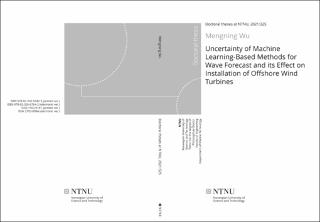| dc.description.abstract | Marine operations, such as offshore lifting and mating, are complex and highly weather-sensitive. When planning these weather-restricted opera-tions, it is necessary to determine the response-based operational limits in terms of sea state variables (i.e., allowable sea states) of the system used in the operations. During the execution phase, the allowable sea states could be compared with the forecasted wave conditions to decide whether the operation should start or not. In order to do this, it is important to make short-term forecasts of wave conditions that are characterized by significant wave height Hs, peak wave period Tp and so on. Given that there is inherent uncertainty in weather forecasts, how to quantify the forecast uncertainty and reflect it when planning and executing marine operations thus become a key issue.
This thesis first addresses the multi-step-ahead wave forecasting by using machine learning-based methods. Different time series-based machine learning (TSML) methods are developed and established, which rely on correlations between data in time series and consist of different preprocessing techniques, data-driven models and multi-step-ahead strategies. In addition to the TSML method, a new efficient and reliable forecasting method, called the physics-based machine learning (PBML) method is proposed by combining the physics-based wave model with machine learning technique. In the PBML model, physical knowledge from physics-based wave models is utilized as a guide for designing inputs and outputs, and machine learning algorithm is adopted to learn the implicit relationships between them.
These machine learning-based methods are employed to forecast one-day-ahead Hs and Tp at the central part of the North Sea. Uncertainty quantification analysis is carried out to evaluate and compare the forecast performance of different methods. This is done by calculating conventional error measures such as RMSE and carrying out statistical analysis of a pre-defined forecast error factor. Results demonstrate the feasibility of applying machine learning algorithms to forecast wave conditions. However, the forecast uncertainty of TSML methods generally increases with the forecast horizon. Since the correlation in the time series of sea state variables decreases significantly with the time interval increases, it is difficult to deal with this phenomenon, whether by changing the data-driven model or developing more complex TSML methods. By comparison, due to the consideration of physical processes, the PBML method can generate more accurate wave forecasts in the whole forecast horizon and the corresponding forecast uncertainties are quite low. Due to the high forecast performance and low computational cost, the PBML method can be conceived as an efficient tool for wave forecasting.
Then the effect of weather forecast uncertainty on marine operations is investigated. In the thesis, a methodology is proposed to assess the allowable sea states for marine operations, with emphasis on considering weather forecast uncertainty. It consists of uncertainty quantification of weather forecasts, statistical analysis of system dynamic responses of coupled system for marine operations and allowable sea states assessment by means of response-based criteria. Based on the methodology, a new response-based alpha-factor αR is derived. This is similar to the α-factor proposed by DNV, but it accounts for the effect of forecast uncertainties of both Hs and Tp on the dynamic response of operations. The αR is defined from the perspective of dynamic response during operation, and depends on the type and duration of marine operations, the characteristics of dynamic system, the weather forecasting method, etc. By applying the αR, allowable sea states in terms of Hs and Tp for the operation can be assessed, taking into account the weather forecast uncertainty at different lead times.
Finally, the proposed methodology is applied to the blade installation of offshore wind turbines as a case study. The final mating phase between the blade root and hub is considered and the crane tip motion, blade root radial motion and velocity are regarded as the limiting response parameters to illustrate the usage of the methodology in frequency- and time-domain, respectively. The αR factors for each limiting parameter are established separately in terms of sea state scenarios and forecast lead times. Then the corresponding allowable sea states are assessed. It is found that there is a significant difference between the allowable sea states with and without considering weather forecast uncertainty and forecast uncertainties in both Hs and Tp have important contributions to it. If weather forecast uncertainties are not included, the allowable sea states would be over-estimated. As the forecast lead time increases, the allowable sea states gradually decrease.
In summary, the original contributions of this thesis include the establishment and development of machine learning-based forecasting methods or wave forecast, the quantification analysis of weather forecast uncertainties, and the development of a methodology for assessment of allowable sea states for marine operations including the effect of weather forecast uncertainty. These are meaningful and have great potential applications in marine operations, which can assist decision-making in the execution phase. | en_US |
